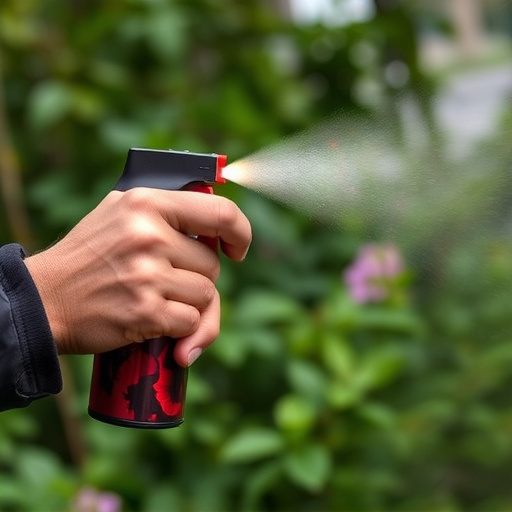Capsaicin in pepper spray triggers a chain reaction with pain, blindness, coughing and breathing difficulty. Immediate care involves eye washing for 15 minutes, skin cleaning, and ventilation for inhalation. Neutralize capsaicin with water and topical creams, seek medical attention for severe cases. Safety measures include goggles, proper ventilation, regular sprayer cleaning, and compliance with local laws. In exposure, remove contaminated clothing, rinse affected areas for 15 minutes, provide oxygen if needed, apply cold compresses and antihistamines for temporary relief while monitoring vital signs.
“Discover the revolutionary potential of Capsaicin-based inflammatory crowd control sprays, a game-changer in public safety. This article explores the powerful active ingredient, capsaicin, and its unique mechanism to block pain pathways, offering an effective, if controversial, solution for crowd management. We delve into the legal landscape surrounding these agents, providing essential insights on use, regulations, and application procedures. Learn critical immediate care techniques for pepper spray exposure, ensuring safety and swift relief.”
- Understanding Capsaicin: The Active Ingredient
- Mechanism of Action: How It Blocks Pain
- Legal Considerations: Use and Regulations
- Application and Safety Measures for Users
- Effective Immediate Care Techniques After Exposure
Understanding Capsaicin: The Active Ingredient
Capsaicin, the active ingredient in pepper spray, is a natural compound derived from chili peppers. It’s what gives them their heat and pungent scent. When inhaled or makes contact with skin, capsaicin triggers a cascade of physiological responses. Nerve endings detect the compound, sending signals to the brain that interpret it as pain and irritation. This immediate reaction leads to temporary blindness, coughing, and difficulty breathing—effects crucial for crowd control situations.
Understanding how capsaicin works is essential in providing immediate care for pepper spray exposure. Eye protection is vital; affected individuals should wash their eyes with clean water for at least 15 minutes. Clothing should be thoroughly cleaned to prevent prolonged skin irritation. If inhalation occurs, moving to a well-ventilated area and seeking fresh air is critical. Medical attention may be required in severe cases to manage symptoms effectively.
Mechanism of Action: How It Blocks Pain
Capsaicin, the active ingredient in pepper spray, disrupts pain signaling pathways through its mechanism of action. When capsaicin comes into contact with the skin or mucous membranes, it binds to specific receptors called transient receptor potential (TRP) channels, particularly TRPV1. This binding triggers a cascade of events that lead to the release of neurotransmitters and the activation of sensory neurons responsible for pain perception.
The immediate care for pepper spray exposure involves neutralizing these effects. Washing the affected area with plenty of water helps flush out capsaicin. Additionally, applying topical creams or lotions containing ingredients like benzocaine or lidocaine can provide temporary relief by blocking nerve impulses and numbing the skin. These measures help alleviate pain and discomfort associated with capsaicin exposure until the body naturally clears the irritant.
Legal Considerations: Use and Regulations
The use of capsaicin-based inflammatory crowd control sprays, often referred to as pepper spray, is subject to various legal considerations and regulations worldwide. These laws differ significantly from country to country, and even within regions of a single nation. In many jurisdictions, law enforcement agencies are authorized to deploy such agents for crowd control during demonstrations or public disturbances, provided they adhere to strict protocols for minimizing harm.
Immediate care for pepper spray exposure is a critical aspect that legal frameworks often address. Victims of pepper spray ingestion or inhalation require prompt medical attention. Regulations typically mandate the availability of de-escalation strategies and irrigation facilities at the scene to offer immediate relief to those affected. Additionally, laws may dictate who can purchase and possess these crowd control agents, with restrictions aimed at preventing misuse and ensuring public safety.
Application and Safety Measures for Users
Application and Safety Measures for Users
When using a capsaicin-based inflammatory crowd control spray, proper application is key. Aim for the eyes, face, and respiratory areas—these sensitive regions trigger an immediate reaction. However, users should exercise caution to avoid unintended targets, as it can cause severe discomfort and pain. Safety goggles or a face shield can protect against splatter. In case of accidental exposure, immediate care is crucial. Flush affected areas with plenty of water for at least 15 minutes. Seek medical attention if irritation persists or symptoms worsen.
For users handling the spray, ensure proper ventilation to prevent inhalation of the irritant. Wear protective clothing, including gloves and long-sleeved apparel, to minimize skin contact. Regularly clean and maintain the sprayer to avoid contamination. Store the spray in a secure location, out of reach of children and unauthorized individuals. Familiarize yourself with local laws and regulations regarding crowd control measures to ensure compliance during use.
Effective Immediate Care Techniques After Exposure
After exposure to a capsaicin-based inflammatory crowd control spray, immediate and effective care is crucial to mitigate symptoms and ensure safety. The first step is to remove any contaminated clothing or shoes, as the chemical can adhere to fabrics. Rinse affected areas with plenty of water for at least 15 minutes to wash away the irritant. This simple action can significantly reduce skin and eye irritation.
For respiratory distress, move the individual to a well-ventilated area and administer oxygen if trained to do so. Soothing eye discomfort can be managed by gently flushing with clean water or using eye irrigation equipment if available. Medical professionals should monitor vital signs and assess for any systemic reactions. Applying cold compresses to affected areas may provide temporary relief from pain and swelling, and antihistamines can help alleviate itching and skin redness.
Capsaicin-based inflammatory crowd control spray, while a powerful tool for immediate care in certain situations, comes with legal considerations and application safety measures. Understanding its mechanism of action and knowing effective immediate care techniques after exposure are crucial. Always prioritize safety and adhere to regulations when using such agents. In the event of accidental exposure, prompt and appropriate immediate care can significantly reduce discomfort and potential long-term effects.
